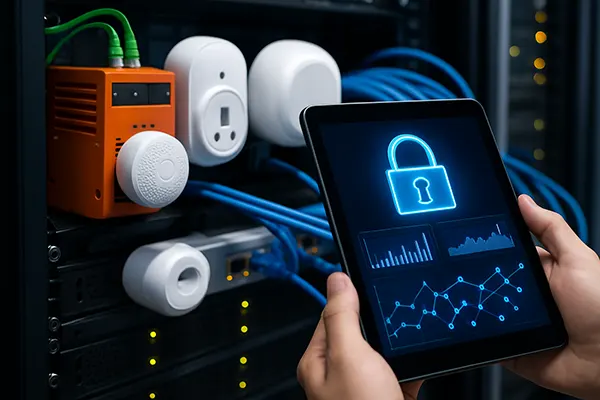
Zero-trust architecture for IoT: securing large-scale device connectivity in modern enterprises
Organisations that rely on connected sensors, controllers and embedded devices face rising security pressures as IoT ecosystems expand. Each device may introduce additional exposure, especially when it has limited computational power, irregular update cycles or is installed in locations where physical access cannot be controlled. A zero-trust approach helps enterprises manage these risks by assuming that no device, network segment or user is inherently safe, and that every interaction requires verification. This mindset is essential in 2025, as IoT deployments operate across critical industries from manufacturing lines to healthcare facilities.
Core principles of zero-trust in the context of IoT
Zero-trust for IoT applies the general “never trust, always verify” concept to distributed low-power hardware. Instead of relying on perimeter controls, the architecture treats each device as a potentially compromised node. This is important because many IoT components lack strong processors, making it difficult to run traditional security agents or advanced endpoint tools. Attackers may attempt to exploit outdated firmware, unsecured wireless communication or access gained through the physical environment, which is why constant authentication and monitoring become critical design elements.
Most zero-trust frameworks use micro-segmentation to reduce the potential blast radius of a breach. By dividing a network into isolated zones, organisations can restrict device communication to only what is operationally required. This prevents lateral movement across industrial systems, smart building infrastructure or medical sensors. Encryption of traffic between segments helps prevent interception or manipulation of telemetry data, even if part of the network is exposed.
Device identity is another foundational component. In zero-trust environments, each IoT unit must present verifiable credentials such as hardware-rooted cryptographic keys or certificates. These allow management systems to check that a device is genuine, properly configured and authorised for its assigned functions. Continuous authentication ensures that even approved devices undergo regular verification during their operation.
Known challenges influencing the introduction of zero-trust
IoT fleets often include a mixture of legacy devices and modern hardware, making standardised implementation difficult. Older controllers may not support strong encryption or certificate-based identity, forcing organisations to use additional gateways or proxy layers to perform security functions on their behalf. This increases architectural complexity and requires precise configuration to avoid introducing additional weak points.
Physical access remains an ongoing concern. Devices in production lines, warehouses, outdoor installations or patient rooms where staff and third-party technicians rotate frequently may be exposed to tampering. Attackers might attempt to modify firmware, connect unauthorised peripherals or replace legitimate units with malicious look-alikes. Zero-trust helps reduce the impact of such interference, but organisations still need policies for access control, inspection and tamper-evident hardware.
Finally, consistent firmware and security updates pose logistical difficulties when thousands of devices run different operating systems or proprietary modules. A zero-trust environment requires clear update pipelines, automated validation and rollbacks to ensure devices remain secure without disrupting operational uptime.
Architectural elements that support zero-trust for IoT ecosystems
Micro-segmentation creates smaller communication zones that limit interactions between distinct device groups. In manufacturing, production robots may be placed in separate segments from quality-control sensors or energy-monitoring units. In smart buildings, heating, lighting and safety systems can be kept apart to avoid interdependencies that could be exploited by attackers. This segmentation allows organisations to apply targeted security controls that reflect the operational risk of each zone.
Encryption of data both in transit and at rest is essential. Lightweight cryptographic protocols, designed for low-power hardware, ensure that even resource-constrained devices can maintain secure communication without overloading processors. Using secure key-management systems helps maintain the integrity of encrypted traffic and prevents misuse of cryptographic material.
Strong device authentication and trust models support controlled onboarding. Enterprises can use hardware-based keys, secure boot mechanisms and remote attestation to validate that a device is running approved firmware. Such checks are important in sectors like healthcare, where every sensor feeding patient data must be verified, or industrial settings where a single compromised controller could disrupt production.
Real-world applications across different industries
In industrial environments, zero-trust helps protect programmable logic controllers, robotic systems and sensor arrays involved in high-precision operations. Manufacturing lines frequently integrate equipment from multiple vendors, resulting in mixed trust levels. By isolating subsystems and validating each communication request, factories reduce the chances of downtime caused by unauthorised interference.
Smart building systems benefit from the same discipline. Heating, ventilation, lighting, energy meters and access-control units communicate continuously. Without a zero-trust approach, an exploited lighting sensor could provide an entry point to the facility’s access system. Segmentation and authentication prevent cross-system compromise and ensure each subsystem operates within defined boundaries.
Medical institutions introduce IoT devices into patient rooms, laboratories and diagnostic areas. These devices collect sensitive data and sometimes support life-critical functions. Zero-trust ensures that only authorised equipment can exchange information with hospital servers, while continuous monitoring helps detect anomalies that could indicate tampering or malfunction.

Steps for implementing zero-trust in large IoT deployments
The first step involves assessing risks across all device categories. Organisations must catalogue hardware, identify vulnerabilities, analyse communication patterns and determine which components need priority protection. This assessment forms the baseline for micro-segmentation and authentication policies tailored to operational needs.
Technology selection comes next. Organisations choose encryption frameworks, identity solutions, secure gateways, monitoring systems and analytics engines capable of handling large device volumes. Compatibility and long-term maintenance become key considerations because IoT lifecycles often exceed those of traditional IT equipment.
Continuous monitoring and incident response complete the framework. Behavioural analytics detect unusual patterns such as sudden communication spikes, changes in device posture or attempts to access restricted segments. Automated responses can isolate compromised devices, restrict privileges or alert security teams before harm occurs.
Frequent mistakes and ways to avoid them
One common mistake is attempting to apply zero-trust principles without a clear inventory of devices. When organisations lack visibility into their IoT landscape, segmentation and authentication rules become inconsistent or incomplete. Maintaining an accurate device catalogue and regularly updating it is essential for dependable security design.
Another error is underestimating the need for scalable key management. Without proper handling of certificates, keys and identity credentials, devices may fail authentication or continue using expired material. Enterprises must implement automated key-rotation policies and reliable cryptographic storage to prevent these issues.
Finally, organisations may focus heavily on technical controls while neglecting operational processes. Staff training, physical access procedures and clear incident-escalation paths are vital. Zero-trust succeeds only when technological and organisational measures work together to minimise overall risk.





